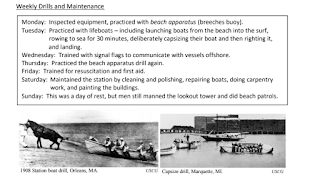I have to tell you that one of the main reasons my son was interested in reviewing this item was because our last name is Locklear 😃 He just thought for sure that somehow we might be related to Rebecca Locklear. I don't believe there is any relation, but we still had a wonderful time reading Exploring the U.S. Life-Saving Service 1878-1915: 17 Student Workshops with 120 Activities . Ever since our oldest son joined the Army our youngest son has developed an amazing fascination with the military and all types of similar services. There is so much information in this 117 page e-book that is filled with hands-on activities, skits, music, research, art and much more. After looking through the book I decided that I'd do most of the reading out loud because we seem to be in a great groove with that lately. When Issac can sit and listen or do an activity he seems to stay much more focused and engaged in the learning. We decided we'd just start at the beginning and read right through the book. I was really excited to go over the survival skills section with my son, but honestly all of them were so interesting we didn't want to miss any.
We started off with an overview of the U.S. Life-Saving Service. I have to admit that I hadn't heard of them before, but I found the information to be fascinating! We learned that on the East Coast these stations were 6-8 miles apart, but on the West Coast there were fewer stations because the ports were further apart. We learned what the names of the different people in the stations were called. The Keeper was the man that ran the location. The Surfman were the actual crew members and were usually local fishermen. The locals knew the waters and were skilled with the boats. The Surfmen were ranked according to their experience and duties. My son was shocked to find out that they were only paid $65.00 a month. They worked Sept. through June. They did have to pay for their own clothing, but the wages were considered to be good. At the end of the season they were done and if they did a good job then they'd possibly be rehired the next season.
The men took turns cooking and had to have meals ready at 7 a.m., noon and 4 p.m. Since they had to buy their own food they typically tried to hunt and fish. In their free time they had to be within earshot of the alarm bell in case they were needed. One day a week they were off and allowed to go home and see their family. My son thought it might be kind of cool to only see his dad one day a week. He seemed to think he's have to do less if his dad wasn't around. I reminded him how much he enjoyed shooting basketball, throwing football and playing board games with his dad and they'd only be able to do that one day a week. He didn't think it sounded so fun then.
Their daily work included lookout duty which was in 4 hour shifts. They had to walk during this time and ring a bell every 30 minutes to show that he was focused on the task. If it was foggy then they spent the 4 hour shift walking the beach. Th
ey also continually trained to be prepared to save lives. Things were so much harder and dangerous back then to try and save those at sea. The only way they could communicate to the vessel in trouble was by yelling or signally with flags. We learned what SOS was started and it wasn't exactly what we thought! When a rescue was needed it was the Keeper who made the ultimate decision about what to do. Imagine being in the dark of night with waves that could be 10 feet high. They had to drag their rescue boats through the sand and they weighed about 900#'s. The Surfmen had to be physically fit, mentally touch alert and ready to push through whatever came their way. We also learned that they had to be able to recognize what type of ship was in the water just by the shape! Amazingly enough we learned that once the crew were on the scene of a wreck the survival rate was almost 99%. I found that pretty impressive for all that they had to overcome. We also learned that the men liked to play practical jokes on each other and that it was all part of the bonding process.
ey also continually trained to be prepared to save lives. Things were so much harder and dangerous back then to try and save those at sea. The only way they could communicate to the vessel in trouble was by yelling or signally with flags. We learned what SOS was started and it wasn't exactly what we thought! When a rescue was needed it was the Keeper who made the ultimate decision about what to do. Imagine being in the dark of night with waves that could be 10 feet high. They had to drag their rescue boats through the sand and they weighed about 900#'s. The Surfmen had to be physically fit, mentally touch alert and ready to push through whatever came their way. We also learned that they had to be able to recognize what type of ship was in the water just by the shape! Amazingly enough we learned that once the crew were on the scene of a wreck the survival rate was almost 99%. I found that pretty impressive for all that they had to overcome. We also learned that the men liked to play practical jokes on each other and that it was all part of the bonding process.
We learned about the different types of boats, the drills they ran through and about some of the items that they cooked. I was really interested in the steamed bread, but we ultimately went with the baked beans. Issac wasn't sure about trying "old" food as he put it, but he really enjoyed them after they were done.
We learned quite a bit about the life saving techniques and things to look out for especially in the cold. We learned about the five priorities for survival activity.
** The will to live
** Shelter
** Water
** Food
** Signal
We learned how important these were and how they each could affect your chances of survival. One thing I noticed with my son as we working through some of the activities were things like he said he doesn't hike. It made it hard for him to think about what type of first aid equipment he might need since he doesn't hike. We discussed how he might not hike now, but in 10 years he might decide to and he needs to know it's better to be prepared than to not be prepared. One thing that I learned was about accidental hypothermia. I hadn't thought about if you have been sweating heavily and you lie down because your tired that accidental hypothermia can happen. I've always thought about it when you were in the water, but the wet clothing can still bring your body temperature down below normal. We also learned what 1-10-1 means regarding hypothermia.
** For 1 minute the person will be in shock when they go into the water.
** In about 10 minutes you can become incapacitated in the water.
** A person may have no more than 1 hour to remain conscious in the water.
Learning about these things helped us to know how important it is to try and stay calm and collected if we were to go into the water. Issac wondered why the rescuers don't get hypothermia and we learned it's because they were typically rowing and that kept their core warm. We went over what hypothermia looks like on a person, so that hopefully if we were in that situation we would recognize the signs and be of help.
There were so many activities and things to do in Exploring the U.S. Life-Saving Service 1878-1915: 17 Student Workshops with 120 Activities that we couldn't possibly do them all. I truly like when there are so many options because then we can pick and chose which to do. My son didn't really care for the art or music, but he enjoyed the stories and all of the pictures. Some of the activities I thought would be better for a larger family, co-op or school setting. My son really didn't have anyone to discuss or bounce ideas off of other then me. This would make a great unit study with all the research activities and projects. We greatly enjoyed the videos and even purchased Shipwreck Season by Donna Hill to continue our fun.
Check out Rebecca's blog and sign up for her emails to keep up-to-date. We had 63 reviewers this time and some were using the e-book we used and some were using The Mayflower at Cape Cod - Stories, activities, and research that connect 1620 with life today. Go check out and see what the other reviewers learned and what type of projects they made.





















No comments:
Post a Comment